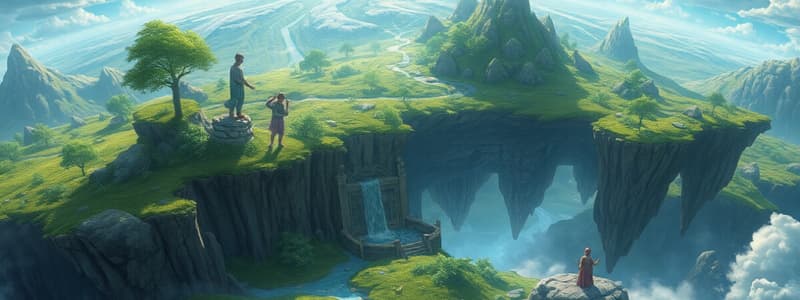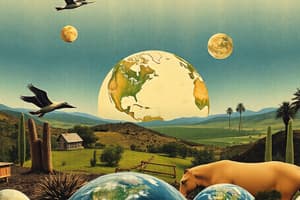Podcast
Questions and Answers
Which sphere of the Earth is composed of the solid outer layer including the crust and upper mantle?
Which sphere of the Earth is composed of the solid outer layer including the crust and upper mantle?
- Hydrosphere
- Lithosphere (correct)
- Atmosphere
- Biosphere
The biosphere includes only the living organisms on Earth.
The biosphere includes only the living organisms on Earth.
False (B)
What are the two main types of factors that make up an ecosystem?
What are the two main types of factors that make up an ecosystem?
Biotic and abiotic factors
Coral reefs are primarily made up of tiny individual corals called _______.
Coral reefs are primarily made up of tiny individual corals called _______.
Match the following terms with their correct definitions:
Match the following terms with their correct definitions:
Which of the following is a biotic factor?
Which of the following is a biotic factor?
Natural ecosystems are always large in size.
Natural ecosystems are always large in size.
What major threats are faced by coral reefs?
What major threats are faced by coral reefs?
What is the primary source of energy for almost all organisms on Earth?
What is the primary source of energy for almost all organisms on Earth?
Photosynthesis produces carbon dioxide as one of its products.
Photosynthesis produces carbon dioxide as one of its products.
What are the reactants of photosynthesis?
What are the reactants of photosynthesis?
The complementary process to photosynthesis that releases energy is called __________.
The complementary process to photosynthesis that releases energy is called __________.
Match the following terms with their definitions:
Match the following terms with their definitions:
What lesson does 'The Lorax' convey about ecosystems?
What lesson does 'The Lorax' convey about ecosystems?
Converting radiant energy into thermal energy accounts for nearly 70% of the energy absorbed by the Earth’s surface.
Converting radiant energy into thermal energy accounts for nearly 70% of the energy absorbed by the Earth’s surface.
Why are ecological niches important for ecosystems?
Why are ecological niches important for ecosystems?
Which type of consumer eats both producers and consumers?
Which type of consumer eats both producers and consumers?
A food web consists of a single linear path of energy transfer.
A food web consists of a single linear path of energy transfer.
What is biomass?
What is biomass?
Decomposers feed on __________ organisms.
Decomposers feed on __________ organisms.
Which of the following cycles involves the conversion of nitrogen gas into forms usable by living organisms?
Which of the following cycles involves the conversion of nitrogen gas into forms usable by living organisms?
Match the following types of ecological pyramids with their descriptions:
Match the following types of ecological pyramids with their descriptions:
What role do scavengers play in an ecosystem?
What role do scavengers play in an ecosystem?
Photosynthesis plays a crucial role in the carbon cycle by allowing plants to absorb carbon dioxide.
Photosynthesis plays a crucial role in the carbon cycle by allowing plants to absorb carbon dioxide.
Which of the following is considered a biotic factor that can limit the size of a population?
Which of the following is considered a biotic factor that can limit the size of a population?
Abiotic factors only refer to non-living components of an ecosystem.
Abiotic factors only refer to non-living components of an ecosystem.
What is the term for the range in which a species can survive based on environmental factors?
What is the term for the range in which a species can survive based on environmental factors?
The relationship where one organism benefits at the expense of another is known as __________.
The relationship where one organism benefits at the expense of another is known as __________.
Match the following types of species interactions with their definitions:
Match the following types of species interactions with their definitions:
What is carrying capacity?
What is carrying capacity?
Human activities can act as limiting factors in ecosystems.
Human activities can act as limiting factors in ecosystems.
Name one reason why there are limits on fishing and hunting.
Name one reason why there are limits on fishing and hunting.
Flashcards
Lithosphere
Lithosphere
The solid outer layer of Earth, made up of the crust and upper mantle.
Atmosphere
Atmosphere
The layer of air surrounding Earth, regulating temperature and protecting from radiation.
Hydrosphere
Hydrosphere
All Earth's water—oceans, rivers, lakes, ice, and streams.
Biosphere
Biosphere
Signup and view all the flashcards
Ecosystem
Ecosystem
Signup and view all the flashcards
Biotic factor
Biotic factor
Signup and view all the flashcards
Abiotic factor
Abiotic factor
Signup and view all the flashcards
Coral Reef Threats
Coral Reef Threats
Signup and view all the flashcards
Sustainability importance
Sustainability importance
Signup and view all the flashcards
Photosynthesis source of energy
Photosynthesis source of energy
Signup and view all the flashcards
Photosynthesis
Photosynthesis
Signup and view all the flashcards
Photosynthesis reactants
Photosynthesis reactants
Signup and view all the flashcards
Photosynthesis products
Photosynthesis products
Signup and view all the flashcards
Cellular respiration
Cellular respiration
Signup and view all the flashcards
Ecological niche
Ecological niche
Signup and view all the flashcards
Energy role of photosynthesis
Energy role of photosynthesis
Signup and view all the flashcards
Herbivore example
Herbivore example
Signup and view all the flashcards
Food Chain
Food Chain
Signup and view all the flashcards
Trophic Level
Trophic Level
Signup and view all the flashcards
Biomass Pyramid
Biomass Pyramid
Signup and view all the flashcards
Omnivore
Omnivore
Signup and view all the flashcards
Carbon Cycle
Carbon Cycle
Signup and view all the flashcards
Nitrogen Cycle
Nitrogen Cycle
Signup and view all the flashcards
Ecological Pyramid
Ecological Pyramid
Signup and view all the flashcards
Limiting factors
Limiting factors
Signup and view all the flashcards
Tolerance range
Tolerance range
Signup and view all the flashcards
Carrying capacity
Carrying capacity
Signup and view all the flashcards
Competition
Competition
Signup and view all the flashcards
Parasitism
Parasitism
Signup and view all the flashcards
Mutualism
Mutualism
Signup and view all the flashcards
Predation
Predation
Signup and view all the flashcards
Study Notes
Earth's Spheres
- Earth has four main spheres: lithosphere, atmosphere, hydrosphere, and biosphere.
- Lithosphere: The solid outer layer of Earth, consisting of the crust and upper mantle.
- Atmosphere: The layer of air surrounding Earth, regulating temperature and protecting from radiation.
- Hydrosphere: All of Earth's water, including oceans, rivers, lakes, and ice.
- Biosphere: The realm of all living things on Earth.
- These spheres are interconnected and rely on each other for survival.
Ecosystems
- An ecosystem is all living organisms in a region interacting with each other and their non-living environment.
- Biotic factors: Living things, their remains, products, and wastes (e.g., animals, plants, nests).
- Abiotic factors: Non-living things (e.g., temperature, wind, water, air, minerals).
- Ecosystems contain different levels of organization:
- Organism: Individual living thing
- Population: All members of the same species in an area
- Community: All populations in an area
- Ecosystem: All living and non-living things in an area
Ecological Niches
- An ecological niche is the function a species serves in its ecosystem, including what it eats, what eats it, and how it behaves.
- Each species occupies a unique niche.
- Common consumer types and examples include:
- Herbivore: Eats only producers (e.g., plants)
- Carnivore: Eats only consumers (e.g., animals)
- Omnivore: Eats both producers and consumers
- Scavenger: Eats dead remains (e.g., vultures)
- Decomposer: Feeds on dead decaying organisms (e.g., fungi)
Food Chains and Webs
- Food chain: A sequence of organisms, each feeding on the next, showing energy transfer.
- Food web: A representation of feeding relationships within a community (a more complex depiction than a food chain).
- Trophic level: The feeding level of an organism in a food chain or web.
Ecological Pyramids
- Biomass pyramids: Show total mass of organisms at each trophic level.
- Types of pyramids also include Energy and Numbers pyramids.
Biogeochemical Cycles (Carbon and Nitrogen)
- Carbon cycle: Carbon moves from the atmosphere to plants through photosynthesis, then to animals through consumption, and returns to the atmosphere after an organism dies. Decomposers play a significant role.
- Nitrogen cycle: After plants absorb nitrogen, it moves through the food chain. After organisms die, decomposers release nitrogen into the environment.
Limiting Factors
- Limiting factors are factors that restrict population size.
- These can be biotic (e.g., food availability) or abiotic (e.g., water availability).
- Limiting factors affect the tolerance range of a species—the upper and lower limits of their survival and reproduction.
Species Interactions
- Competition: Organisms vying for limited resources
- Parasitism: One organism (parasite) benefits at the expense of another (host).
- Commensalism: One organism benefits, while the other is neither harmed nor helped.
- Mutualism: Both organisms benefit.
- Predation: One organism (predator) kills and eats another (prey).
Carrying Capacity
- Carrying capacity is the maximum population size an environment can support.
- Sustainability is linked to carrying capacity as exceeding carrying capacity can harm the environment and the organisms within.
Studying That Suits You
Use AI to generate personalized quizzes and flashcards to suit your learning preferences.




